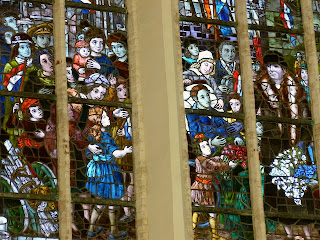 |
|
“Joep Nicolas worked on these windows during the last twelve years of his life. Although he was a mature painter and a master glazier, it was evident his work evolved during the tenure of the project. This window is the greatest, in my opinion. It is a presentation of what was transpiring in the heavenlies during the dark period when Nazi Germany engulfed Holland. The lowest creature in the composition is a beast with ten heads and ten crowns and the heads are heads of lions. This image is taken from the apocalyptic Book of Revelation. Above the beast, angels of God war against it. Above them are figures of people in the Bible, or they could be called Saints. The red sun is the sun of freedom, and there are badges which look like they are represent armies of the conflict on earth, including the Stars and Stripes of the USA,” wrote Gowing.
|
Toby Gowing recently visited the
Oude Kerk in Delft in order to study the stained glass windows of Joep Nicolas, who, as she says, “is someone I had never heard of until my recent interest in stained glass, an artist who should be famous for this work.” Her photos of these windows are so exquisite I asked her if I could share them here.
Joep Nicolas (1897-1972) was a third-generation glazier, learning his craft in the family studio founded by his grandfather in 1855. He was considered an innovator in glass painting during his lifetime. By the age of 25, he was creating professional church windows; at age 28 he had won a major prize at the Exposition Internationale des Arts Décoratifs et Industriels Modernes in Paris.
Nicolas lived in the United States from the start of WWII until 1958, and made 22 church windows here.
After his return to the Netherlands, he was commissioned to do the windows of the Oude Kerk. These windows are his most famous works.
“This is all glass, and everything that looks drawn or shaded is hand painted, said Gowing. “It has to be painted in a special process and then fired. Nicolas was a master of this process.”
Click on any image to enlarge:
 |
| “The Beast and the Angels. Please remember that direct sunlight was not coming through this window – only ambient light shone through, yet the colors are rich.” |
 |
| “The Dutch text says: In the Year of Our Lord 1945, the dragon of calamity (evil dragon) was defeated by the army of righteousness. After a long night of darkness, the sun of freedom rose over our land and gave new splendor to the experience of our Biblical faith.” |
“The Adam and Eve window is also organized in levels evoking the Creation, while the first couple stands surrounded by animals. The four rivers are being poured from vessels, and a wonderful spouting whale navigates the sea. Above Adam and Eve are the birds of the air.”
 |
| Detail. |
 |
| “Beneath the sea, time advances and we have civilization.” |
 |
| More detail of the sea. |
 |
| “The four winds and the hand of God.” |
 |
| “In addition to being the site of Joep Nicolas’ work, a great painter was buried here.” |
 |
| “Back to the great battle: the Army of Righteousness.” |
 |
| “A detail from The Four Horsemen of the Apocolypse: the Pale Rider on a Pale Horse. This window was completed by Nicolas’ nephew after his death.” |
 |
| “The Four Horsemen: white horse, red horse, black horse, pale horse. Magnificent composition.” |
 |
| “This is another masterpiece in the Oude Kerk: The Liberation Window. From 1945: ‘In her first visit to her country after five years of exile, Queen Wilhelmina visited every town, every village and every hamlet that she could fit into a 10-day tour of liberated areas in Holland. The 65-year-old Queen did not spare herself. She saw the vast stretches of inundated countryside, which will remain barren for years to come even after the bombed dikes of The Netherlands are repaired. She saw the debris of towns where fighting took place only a few days before her visit, gave sympathy and solace to men, woman and children who were wounded or bereaved. She met the valiant miners of Hoerlan and Venlo. Wherever she stopped, she talked with the men and women who fought stubbornly and silently in the Dutch Resistance Movement. It was announced March 23, 1945, that the unofficial, unplanned tour had ended with queen Wilhelmina’s return to England. The queen was born in the Hague in 1880 and has reigned on the Dutch throne since 1890. When the Germans invaded Holland in May, 1940, Queen Wilhelmina was forced to flee to England.'” |
 |
| Detail. |
“And here is where this incredible stained glass window resides. Above a bathroom placed in front so that you can only see this great work of art from a distance.”
“How many people have gone in there to see the Vermeer stone and never looked up?” asked Gowing. “Why build a bathroom directly in front of the second-greatest window in the Kerk? You literally cannot see the window up close. It is obviously a new bathroom meant for tourists. I suppose they couldn’t cut out the gift shop.”
“I wanted to learn more about Queen Wilhelmina. I found this picture of her on her post-war tour, acknowledging the salute of a Boy Scout Troop. Here is the Queen, dressed in the very clothing of the Liberation Window. The same hat, dark jacket, and fox fur, head and all, complete with a bouquet.”
August and September are sold out for my workshop at Lakewatch Manor in Rockland, ME. Join us in June, July and October, but please hurry! Check here for more information.






















